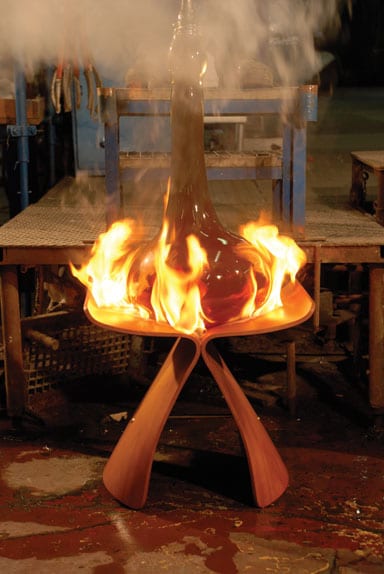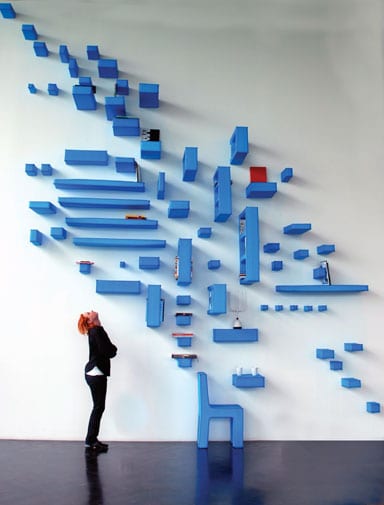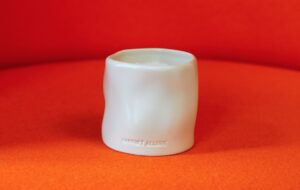words Anna Bates
Half an hour ago Pieke Bergmans was supposed to turn right. The Amsterdam-based designer is driving me to a glass-blowing factory, but she got talking about her desire to infect an assembly line so each of the 100,000 Heineken bottles it produces a day comes out different. She was gesticulating, both hands raised off the wheel, as we flew past the sign to Leerdam. We are now well into the icy countryside, surrounded by locals skating on frozen canals, bogs and lakes.
“Hmmmmm,” repeats Bergmans for the third time, trying to assess the best way to get us off a road that doesn’t seem to have any exits. We are running late for an appointment to watch the making of one of Bergmans’ Crystal Viruses – an object that can visually be described as a blobby vase slopped onto a chair. It is one of a series of pieces for which Bergmans has become well known. Last month alone, variations of this piece were displayed all over the world – from Miami and Lodz, to a small Shoreditch gallery.
But more interesting than Bergmans’ work is her mission. Bergmans wants to design mass-production processes that allow each product to emerge from the assembly line looking different. This is a goal being pursued by many digital designers, but Bergmans is taking a more craft-based approach. I’ve come here to find out how close she’s getting to customised production.
“In nature everything is mass-produced and there are so many differences,” says Bergmans. In her studio in Amsterdam’s red-light district, where we met two hours ago, Bergmans was sometimes vague about her work, using the radio volume and room temperature as excuses to avoid difficult questions. But on the road she opens up a bit, swerving off the line when she’s making a point and getting so into her argument that she almost runs out of petrol. “We are all human beings but there is a certain amount of space to be unique and have personality,” she says. “In the product and in the production of products, I’d like to create a certain amount of space for products to become themselves – to be individual.”
Bergmans titles herself Design Virus. “I wanted to come up with a theme that combined my work together – that was a clear idea,” she says, trying to answer why. “I’m a designer, so I’m like a virus,” she tries. “I want to produce products that spread around the world.” But Bergmans says the title also refers to the way she behaves as a designer: “I’m more of a director,” she says. “I design the process. The process actually designs the piece. My pieces are like a virus,” she tries again. “They grow into different forms to survive … they are alive.”
But Bergmans doesn’t have her head in the clouds. She’s had a plan since age 18, and she’s stuck to it. “I decided not to stay at one school,” explains Bergmans. “Design education institutions are so focused on what they believe in – but it’s just a point of view. I wanted to discover the world – I wanted to experience difference.” So Bergmans pick ‘n’ mixed her education; she developed her conceptual thinking at Design Academy Eindhoven, exploited the vast workshops at the Arnhem Academy of Art and Design, and developed a process at the Royal College of Art. “It’s possible I don’t have an education,” she reflects, but flitting from one school to the next has allowed Bergmans to slowly develop a totally unique method of designing.
Initially, however, this process was lost on her audience. I first saw Bergmans’ work during the Milan furniture fair three years ago. She was exhibiting a series of Crystal Viruses with a video of the process looping in the background. Bergmans’ craftsmen were throwing blown hot crystal “bubbles” onto found chairs, treating the seat as a mould, and allowing the molten material to slip and curl around the edges until it set, the unlikely combinations providing a surreal aesthetic. Watching the process was captivating, but as a design, the end product was disappointing; what do you do with a chair that’s fully occupied by a collapsed vase? The work was beautiful, but it seemed pointlessly conceptual, and it placed Bergmans in exactly the category she didn’t want to be in – a storytelling designer who’d pushed the line too far, and totally sacrificed function for conception; someone who had definitely studied at Eindhoven.
But Bergmans stuck with her process, and soon after came Light Blubs – a series of crystal globes that were “swayed” while still molten to make them look like bulbs gone bad – dripping from the ceiling, or vomiting out of Anglepoise and wall-lights to fantastic effect.
The Blubs stifled the critics. But Bergmans has still only presented a small part of her grand master plan. Bergmans uses the work to explore processes that might lead to the production of unique objects for sale. “I start with an installation, to be free and open-minded and come up with a world,” says Bergmans. “It’s the only way to come up with something new: it leads to products.” So, Bergmans is working on processes that will allow the Blubs and vases to hit the assembly lines and emerge with individuality intact.
If we see the 20th-century ideal of mass-production as the second industrial revolution, Bergmans is among those paving the way to the third – a limitless run of un-identical products. Limited edition has been the watchword in design this century, as designers express a growing desire to make objects that are unique, reflecting society’s growing desire to own customised, individual things. Bergmans wants to take customisation to the high street. Talking about her plans, she makes it sound easy, but I want to know how technically possible it is.
“I’ve already done it,” says Bergmans, sounding very pleased with herself. Unlimited Edition is a series of unique vases produced by a ceramic extruder. To make them, “I put a shape in front of the ceramic extruder,” says Bergmans. “It’s like a machine in front of the machine.” The clay, extruding like toothpaste from a tube, is forced through this shape at increased pressure, directing the final form. The emerging clay is then chopped, caught and quickly helped into form.
“Within production there is space for uniqueness – it doesn’t take any longer to make a unique chair,” says Bergmans. “It just depends on how you programme your computer. I want to change the production mentality. Even the craftsmen find it difficult to be free – they’ve been conditioned to make everything look exactly the same.”
We finally arrive at the factory – it’s freezing, despite being full of blazing furnaces. Bergmans rushes over to nurture her virus, suspended on a stick like a giant lollipop. The molten crystal is lugged over to a steel chair, and carefully placed on the seat while Bergmans directs anxiously. There’s a tense moment as the molten form creeps across the seat, and then Bergmans sighs. It has not gone to plan. It will have to join the other four in the scrap corner. Despite the spontaneous appearance of these objects, this work produces a lot of uniquely shaped failures. Bergmans bites her tongue, and summons up a smile for the badly timed photo-shoot.
It’s hard to imagine how this process could be mass-produced for the market. One process Bergmans is playing with is to use a mould to form the vases, but to make it purposely small so that the molten glass oozes out, creating a different shape each time. For the Blubs, she wants to design a process whereby the glass is moulded, but then blown or swayed a second time – allowing for slight alterations.
The reality at the moment, however, is that Bergmans hasn’t yet managed to sell her infected production plans to the producers. “I’m in it right now,” she insists, but has someone committed? “Uh … not yet. No, not yet.” Manufactured, so far, are a series of clever and not-so-clever compromises. Bergmans’ Reunion Vases for Rosenthal look like a series of bowls randomly stacked on top of each other – so that around the table, positioned at different angles, they each look different. Then there’s the tea towels for Audax Textile Museum Tilburg – a set of ten slightly different towels which in large numbers give the impression that they are all different. “It’s another way of having these variations,” she says.
She isn’t having problems getting products produced, manufacturers are interested in her ethos – no doubt aware that unique pieces sell more – even if they won’t invest in it. Both of her current projects are ready to hit conventional assembly lines; a collection of tables with “infected” legs, where the regular straight lines are substituted with free-styled squiggles, and a shelving series made out of cooked blue foam that evolved from an installation, where the heat is the “virus” that subtly directs the outcome of the final forms.
But Bergmans isn’t satisfied. She is ready to begin the third industrial revolution, and her next challenge is to find and convince a producer brave enough. “I’m going to do everything I can. Call it the dream,” says Bergmans, driving us to the airport (and missing another turning). “To do those Heineken bottles, that would really be something though, eh?”
Portrait by Mel Bles



















